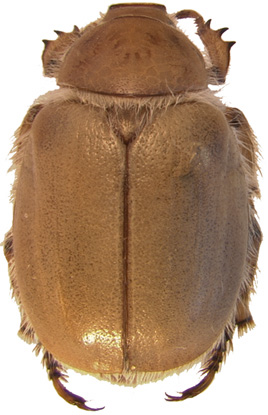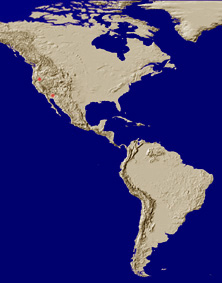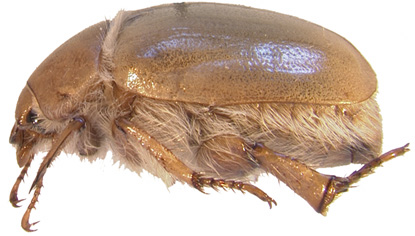 |
|||||||
|
|||||||
Pseudocotalpa Hardy, 1971
Pseudocotalpa andrewsi
photo by Matthew R. Moore
distribution of Pseudocotalpa species
Pseudocotalpa andrewsi
photo by Matthew R. Moore
|
||
| Rutelinae Taxa Map | ||
| Rutelini Taxa Map | ||
| Rutelinae Key | ||
| Rutelini Key | ||
| Areodina Key | ||
| Areodina Gallery |
Diagnosis: Pseudocotalpa is distinguished from the other Rutelinae and Areodina by the following combination of characters: (1) clypeus deeply concave, (2) poorly developed prothoracic postcoxal spine or knob, (3) enlarged, deeply grooved maxillary palp (Hardy 1971).
Distribution: Pseudocotalpa occurs in California and Nevada, south to Mexico (Sonora).
Composition: The genus Pseudocotalpa contains three species: P. andrewsi Hardy, 1971; P. giulianii Hardy, 1974; P. sonorica Hardy, 1974.
Biological Data: Species of Pseudocotalpa have been noted to inhabit areas with loose, drifting sand dunes. Pseudocotalpa species emerge from the dunes at dusk, flying over the sand at a height of a few inches. Pseudocotalpa spend daylight hours buried in the sand at depths below several feet. All three species in the genus Pseudocotalpa exhibit similar behaviors (Hardy 1971; Hardy 1974). Individuals of P. guilianii have been found at depths four to six inches beneath creosote bushes (Larrea divaricata Cav.) (Zygophyllaceae). Females of P. guilianii were observed to emit pheromones from the tips of creosote branches, which attracted hovering males (Hardy 1976). Individuals of P. sonorica fly at dusk between 7:30 and 8:00 pm when temperatures are around 21-24?C and winds are light (Van Dam and Van Dam 2006). Pseudocotalpa sonorica has been observed to fly out of bushes of Croton wigginsii Wheeler (Euphorbiaceae), Eriogonum deserticola S. Watson (Polygonaceae), and Dicoria canescens A. Gray (Asteraceae) (Van Dam and Van Dam 2006). Pseudocotalpa sonorica has been observed to form mating swarms in which a single female attracts many males who fight over access to the female. The distribution of Pseudocotalpa sonorica and P. andrewsi overlaps slightly in the Algodones Sand Dune system in California. Pseudocotalpa sonorica is commonly collected on the tops of dunes, while P. andrewsi is found primarily at the bases of dunes (Van Dam and Van Dam 2006).
Larvae: Van Dam and Van Dam (2006) described the third instar larvae of P. sonorica.
Conservation Status: Pseudocotalpa andrewsi, which is restricted to the Algodones Sand Dunes, was recently surveyed to determine whether the species should be regarded as “threatened” or “endangered” under the Endangered Species Act of 1973. The survey concluded that P. andrewsi is in no immediate need of protection.
References:
Hardy, A.R. 1971. The North American Areodina with a description of a new genus from California. The Pan-Pacific Entomologist 47: 235-242.
Hardy, A. R. 1974. Two new species of Pseudocotalpa Hardy. The Pan-Pacific Entomologist 50: 243-247.
Hardy, A.R. 1976. Observations on the mating behavior of Pseudocotalpa guilianii Hardy. Coleopterists Bulletin 30(3): 301-302.
Hardy, A.R. and F.G. Andrews. 1986. Studies in the coleoptera of western sand dunes. 2. notes on four scarabaeidae from the Algodones Dune system. Coleopterists Bulletin 40(2): 127-139.
Van Dam, Matthew and Alex Van Dam. 2006. Description of the larvae of Pseudocotalpa sonorica Hardy (Scarabaeidae: Rutelinae: Rutelini) with notes on life history. Coleopterists Bulletin 60(01):31-36.
|
||||
|
|


